Refine search
Actions for selected content:
13588 results in History of science and technology
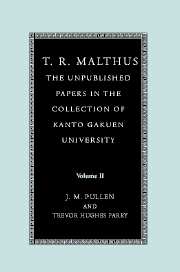
T. R. Malthus: The Unpublished Papers in the Collection of Kanto Gakuen University
-
- Published online:
- 23 December 2009
- Print publication:
- 08 July 2004
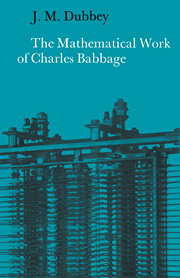
The Mathematical Work of Charles Babbage
-
- Published online:
- 22 December 2009
- Print publication:
- 02 February 1978
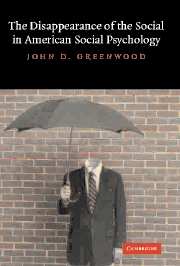
The Disappearance of the Social in American Social Psychology
-
- Published online:
- 18 December 2009
- Print publication:
- 24 November 2003
The problem of raccoon intelligence in behaviourist America
-
- Journal:
- The British Journal for the History of Science / Volume 43 / Issue 3 / September 2010
- Published online by Cambridge University Press:
- 17 December 2009, pp. 391-421
- Print publication:
- September 2010
-
- Article
- Export citation
Test objects and other epistemic things: a history of a nanoscale object
-
- Journal:
- The British Journal for the History of Science / Volume 43 / Issue 3 / September 2010
- Published online by Cambridge University Press:
- 17 December 2009, pp. 423-458
- Print publication:
- September 2010
-
- Article
- Export citation
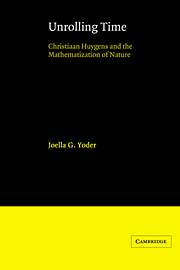
Unrolling Time
- Christiaan Huygens and the Mathematization of Nature
-
- Published online:
- 07 December 2009
- Print publication:
- 24 February 1989

Robert Boyle Reconsidered
-
- Published online:
- 03 December 2009
- Print publication:
- 03 February 1994
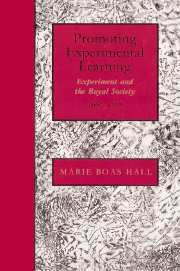
Promoting Experimental Learning
- Experiment and the Royal Society, 1660–1727
-
- Published online:
- 03 December 2009
- Print publication:
- 03 October 1991
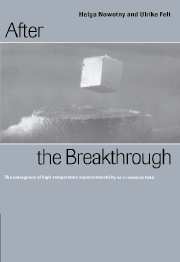
After the Breakthrough
- The Emergence of High-Temperature Superconductivity as a Research Field
-
- Published online:
- 02 December 2009
- Print publication:
- 28 January 1997

An Introduction to the Historiography of Science
-
- Published online:
- 30 November 2009
- Print publication:
- 09 April 1987
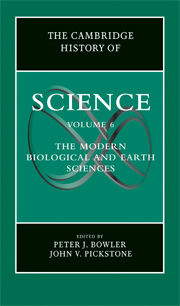
The Cambridge History of Science
-
- Published online:
- 28 November 2009
- Print publication:
- 13 April 2009
BJH volume 42 issue 4 Cover and Back matter
-
- Journal:
- The British Journal for the History of Science / Volume 42 / Issue 4 / December 2009
- Published online by Cambridge University Press:
- 26 November 2009, pp. b1-b4
- Print publication:
- December 2009
-
- Article
-
- You have access
- Export citation
Constance Areson Clark, God or Gorilla: Images of Evolution in the Jazz Age. Baltimore: Johns Hopkins University Press, 2008. xviii+289. ISBN 978-0-8018-8825-0. £23.50 (hardback).
-
- Journal:
- The British Journal for the History of Science / Volume 42 / Issue 4 / December 2009
- Published online by Cambridge University Press:
- 26 November 2009, pp. 608-609
- Print publication:
- December 2009
-
- Article
- Export citation
Stuart Clark, Vanities of the Eye: Vision in Early Modern European Culture. Oxford: Oxford University Press, 2007. Pp. xii+415. ISBN 978-0-19-925013-4. £35.00 (hardback).
-
- Journal:
- The British Journal for the History of Science / Volume 42 / Issue 4 / December 2009
- Published online by Cambridge University Press:
- 26 November 2009, pp. 603-604
- Print publication:
- December 2009
-
- Article
- Export citation
Henry J. Noltie, Robert Wight and the Botanical Drawings of Rungiah and Govindoo. 3 vols. Edinburgh: Royal Botanic Gardens Edinburgh, 2008. Pp. 215, 208 and 88. ISBN 978-1-906129-02-6. £75.00 (paperback, boxed set).
-
- Journal:
- The British Journal for the History of Science / Volume 42 / Issue 4 / December 2009
- Published online by Cambridge University Press:
- 26 November 2009, pp. 606-608
- Print publication:
- December 2009
-
- Article
- Export citation
Books received
-
- Journal:
- The British Journal for the History of Science / Volume 42 / Issue 4 / December 2009
- Published online by Cambridge University Press:
- 26 November 2009, pp. 635-637
- Print publication:
- December 2009
-
- Article
- Export citation
Margareta Tillberg, Tsvetnaia vselennaia: Mikhail Matiushin ob iskusstve i zrenii. Transl. from English by D. Dukhavina and M. Iarosh. Moscow: Novoe Literaturnoe Obozrenie, 2008. pp. 512. ISBN 978 5 867 93600 6. No price given (paperback).
-
- Journal:
- The British Journal for the History of Science / Volume 42 / Issue 4 / December 2009
- Published online by Cambridge University Press:
- 26 November 2009, pp. 609-611
- Print publication:
- December 2009
-
- Article
- Export citation
Aileen Fyfe and Bernard Lightman (eds.), Science in the Marketplace: Nineteenth-Century Sites and Experiences. Chicago and London: University of Chicago Press, 2007. Pp. x+410. ISBN 978 0 226 27650 2. $45.00, £23.50 (hardback).
-
- Journal:
- The British Journal for the History of Science / Volume 42 / Issue 4 / December 2009
- Published online by Cambridge University Press:
- 26 November 2009, pp. 621-623
- Print publication:
- December 2009
-
- Article
- Export citation
Steven Shapin, The Scientific Life: A Moral History of a Late Modern Vocation. Chicago and London: University of Chicago Press, 2008. Pp. xvii+468. ISBN 978-0-226-75024-8. $29.00 (hardback).
-
- Journal:
- The British Journal for the History of Science / Volume 42 / Issue 4 / December 2009
- Published online by Cambridge University Press:
- 26 November 2009, pp. 632-634
- Print publication:
- December 2009
-
- Article
- Export citation
BJH volume 42 issue 4 Cover and Front matter
-
- Journal:
- The British Journal for the History of Science / Volume 42 / Issue 4 / December 2009
- Published online by Cambridge University Press:
- 26 November 2009, pp. f1-f2
- Print publication:
- December 2009
-
- Article
-
- You have access
- Export citation
